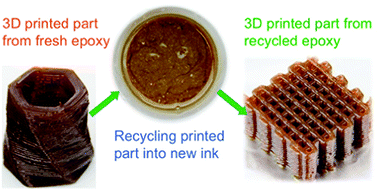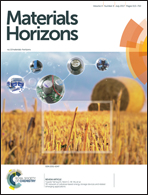Recyclable 3D printing of vitrimer epoxy†
Abstract
3D printing of polymeric materials for various applications has been quickly developed in recent years. In contrast to thermoplastics, 3D printed thermosets, although desirable, are inherently non-recyclable due to their permanently crosslinked networks. As 3D printing is becoming more popular, it is desirable to develop recycling approaches for 3D printed parts in view of increasing polymer wastes. Here, we present a new thermosetting vitrimer epoxy ink and a 3D printing method that can 3D print epoxy into parts with complicated 3D geometries, which later can be recycled into a new ink for the next round of 3D printing. In the first printing cycle, a high-viscous ink is first slightly cured and is then printed at an elevated temperature into complicated 3D structures, followed by an oven cure using a two-step approach. To be recycled, the printed epoxy parts are fully dissolved in an ethylene glycol solvent in a sealed container at a high temperature. The dissolved polymer solution is reused for the next printing cycle using similar printing conditions. Our experiments demonstrate that the ink can be printed four times and still retains very good printability. In addition, the vitrimer epoxy can be used for pressure-free repairs for the 3D printed parts.

- This article is part of the themed collection: Materials Horizons 10th anniversary regional spotlight collection: The Americas


 Please wait while we load your content...
Please wait while we load your content...